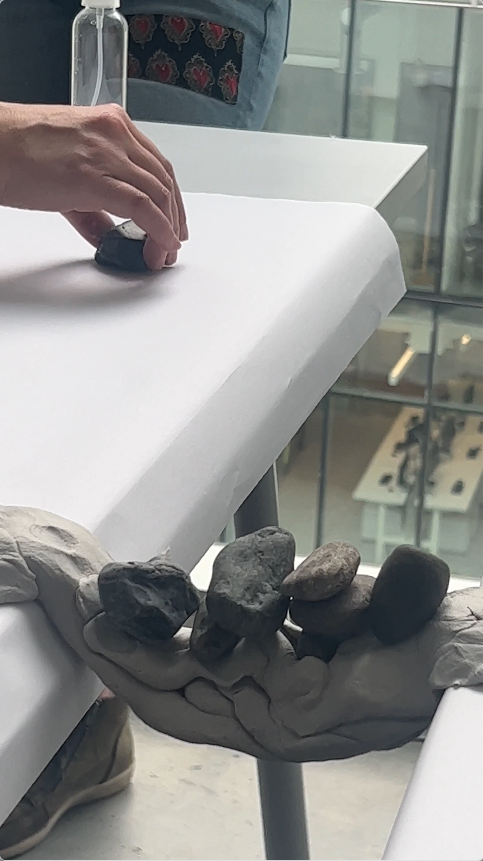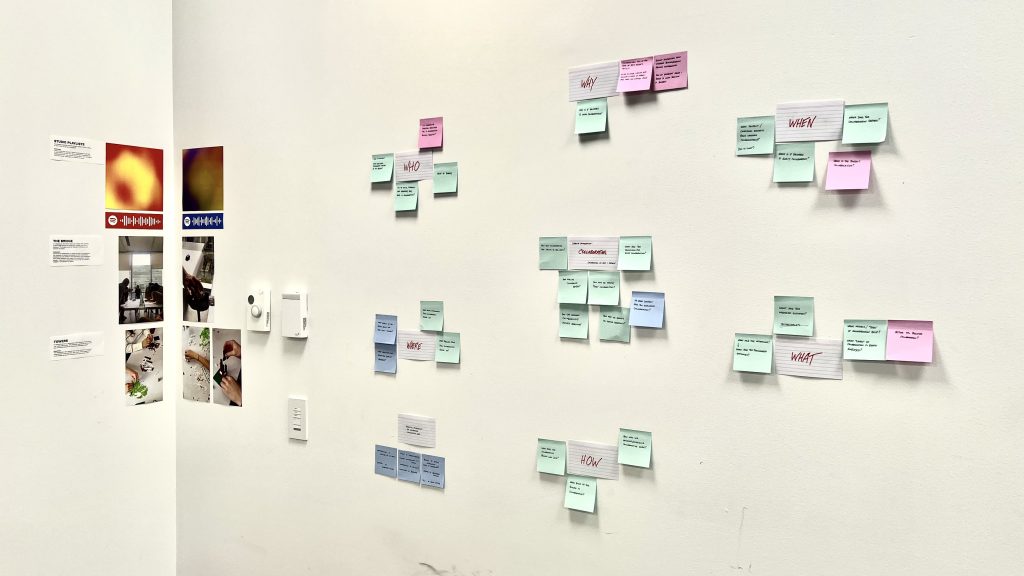Over the course of my first year in the MDes program, I was able to engage with work through the lens of analyzing / understanding collaboration. This involved a few creative sprints including Studio Playlists, The Bridge, and Towers organized within Studio, as well as developing a solid reading list of work that outlines and frames good collaborative models and methods.
Studio Playlists was a project where two Spotify playlists were built by studio-mates: music for focus and music with more energy. This process could be seen as a “passive” form of collaboration, where classmates would add to the playlist on their own time rather than engaging in the same space. Although interesting and collaborative, this was not the phenomenon I aim to explore, however it was a great exploration to delimit my work.


For The Bridge project, classmates were tasked with building a clay bridge across two tables, roughly one foot in distance. The bridge would be tested by holding up any amount of stones. This form of collaboration was closer to what I wanted to explore, the moment to moment processes of collaborators in the same space. This exploration also shared interesting insight, and another layer to consider when analyzing collaboration, of how social dynamics can affect the collaboration in large groups – how some collaborators my not be as inclined to engage in comparison to others.



Finally, Towers tasked small groups of 3, classmates, with building “up” using Lego bricks. This specific exploration did not have any outcomes beyond the final piece standing upright. This project was another example of moment to moment collaboration, with much more engagement in the smaller groups in comparison to the larger class.

Coming to Open Studio, I understand that my research and subsequent work requiring a sense of “world-building” and developing context. where is the collaboration happening? Who is involved? Inspired by this, I chose to begin asking questions surrounding collaboration, beginning with Who, What, Where, When, Why and How…
Who
- who is involved in the collaborative process?
- What does each collaborator bring to the table (funnel)?
- What is the value of diversity in this process?
- How do social dynamics / hierarchy play into a collaboration?
What
- what are the outcomes of the process?
- What are the intentions / prescribed outcomes?
- What are the deliverables?
- What models / “types” of collaboration exist?
Where
- what space does a Collaborative process thrive in?
- What industry are you exploring in regards to collaboration?
- What is required in the physical space (what form of layout / working conditions)?
- What aspect of a studio allows for collaboration to thrive?
When
- what conditions / project benefit from collaboration?
- Back to “what” – when does it make sense to use collaboration?
Why
- Collaborators fill in the gaps within each other’s skillsets
- Access to other experience – industry and life
- More informed body of work
- Access to additional processes and methods – creative and other
How
- What does the collaboration process look like?
- What point of the process is done collaboratively?
- How do we organize / categorize collaborative work?
Overall Research Questions
- How may we collaborate better?
- How can collaboration motivate creativity?
- How do we identify “good” collaboration?
- How may we define creativity?
- what are the ingredients for good communication / collaboration?
Personal Note
I believe it is important to know my own personal relationship with methods of making that I am exploring in my research. Some key ideas that I have arrived to, in regards to my appreciation and process involving collaboration are:
- Working collaboratively, a Collaborators skillset can fill in the gaps of another Collaborator
- Collaborating can provide access to other worlds, experiences, ways of being and making – I find that I can engage with another’s process and world and become inspired for my own work – regardless of industry
- Collaborating with other’s – inputting their expertise and creative ability to a work – can allow room for a more informed and robust body of work
- Insight, information, critique, recommendations, etc. can all be seen as a form of collaboration – where the input can affect the direction of the process
- To dissect collaboration, I have this strange feeling I will need to decide whether or not by scope of work includes researching how people interact and work with each other, or whether the research will focus on creative collaboration